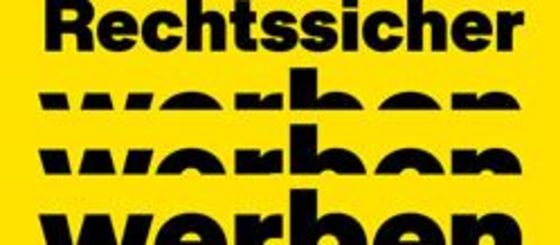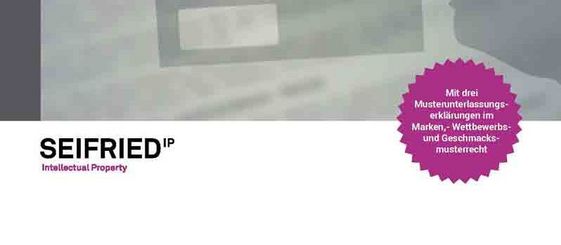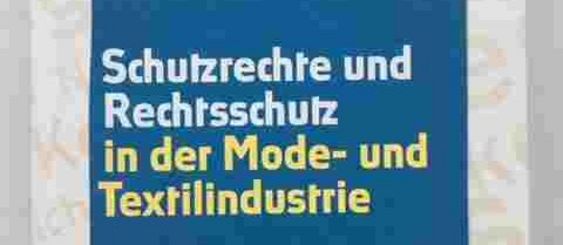Author: Thomas Seifried, trademark lawyer Europe and trademark lawyer Germany
Any questions?
Free initial assessment of your case
Attorney for trademark law Thomas Seifried has over 20 years of experience in trademark law and has also been a specialist attorney for intellectual property law ("Fachanwalt fuer gewerblichen Rechzsschutz") since 2007. He is an author of specialized books and has conducted many successful proceedings before courts and the trademark offices.
Contact us
Free initial assessment
Our initial consultation in trademark law is free of charge.
+49 69 9150760
Here you can send us your documents. We will treat your request strictly confidential.

Praktikerhandbuch zum Werberecht von Thomas Seifried
„Rechtssicher werben", 2. neubearbeite Auflage 2023, 232 Seiten, XchangeIP Verlag, im Buchhandel oder bei Amazon

Kostenloser Download "Abgemahnt - Die erste-Hilfe-Taschenfibel"
Alles über Abmahnungen und strafbewehrte Unterlassungserklärungen, mit Musterformularen
Praktikerhandbuch für die Modeindustrie von Thomas Seifried und Dr. Markus Borbach
„Schutzrechte und Rechtsschutz in der Mode- und Textilindustrie", 368 Seiten, erschienen 2014 in der dfv-Mediengruppe
Compulsory use of a trademark and grace period for use
A trademark must be used. In the case of a German registered trademark, the grace period for use begins as soon as it is no longer possible to file an opposition against the earlier trademark or the opposition proceedings have ended (Sec. 26 Trademark Act). For the EU trademark, the period begins with the registration (Art 18 UMV).
Prerequisite for the use of a trademark preserving the rights
Use as a trademark
The use of a trademark in a way that preserves its rights requires that the trademark has been "used as a trademark", i.e. to identify goods and services (see BGH, judgment of May 31, 2012 - I ZR 135/10, para. 22 - ZAPPA; cf. ECJ [2007] ECR I-7041, para. 21 - Céline). For example, a use of the trademark as decoration is not trademark-related. Such a purely decorative use is not an effective use preserving a right (OLG Frankfurt v. 20.07.2017 - 6 U 149/16 - provadis). The trademark must also have been seriously used. An EU trade mark is put to genuine use if it has been used in a customary and reasonable manner in the Union for the goods and services for which it was registered in order to create or secure an outlet for them (e.g. BPatG v. 27.04.2020 - 25 W (pat) 517/18 HydraProg/Hydra). The classification as "genuine use" of a trademark must be made taking into account the sales volume of the product protected by it, its nature and characteristics, the geographical spread of its use, the advertising and the continuity of its use (ECJ, judgment of 17.07.2014 - Walzer Traum).
Sufficient and insufficient use of a trademark to preserve rights according to case law
A single major supply contract with a single customer may be sufficient for genuine use (BGH, judgment of 25.04.2012- I ZR 156/10 - Orion; BGH of 18.5.2017 - I ZR 178/16 - Glückskekse).
A trademark was not used in a way that sufficiently preserved its rights in the following cases:
- Anyone who distributes his goods free of charge, for example as promotional gifts, does not make genuine use of the trademark (European General Court, judgment of 15.01.2009, C-459/07 - Silberquelle GmbH / Maselli-Strickmode GmbH).
- According to the ECJ, genuine use presupposes that the "items are marketed with the aim of penetrating the market for the goods" (ECJ loc. cit.). What is meant by this is: The goods must be sold. The same applies also, so that the exhaustion under trademark law occurs.
- Likewise, in view of the huge market for clothing, anyone who has only delivered 2,500 polo shirts to intermediaries as goods on commission, received them back and then resold them again as goods on commission in quantities of less than 100 units has not used his trademark (OLG Hamburg, judgment of March 30, 2017 - 3 U 150/15 - admissibility of a further action for revocation)
- A fortiori, a person who can only prove the sale of 75 pairs of jeans does not use his trademark in a way that preserves his rights (European Court of Justice, decision of 08.05.2017 - T-680/15).
- The sale of 170 jackets also does not meet the requirements for a right-preserving use (OLG Düsseldorf v. 19.05.2015 - I-20 U 30/14 - ANAPURNA).
- The sale of a total of 207 polo shirts to seven customers is also not sufficient for a right-preserving use (BGH v. 10.10.2002 - I ZR 235/00 - BIG BERTHA).
- Also, the sale of 40 to 60 kilograms of chocolate products per year, for example, is not sufficient for a right-preserving use (ECJ loc. cit. - Walzer Traum).
- Likewise, it is not sufficient for a right-preserving use if 3,500 units with a total of 40,000 liters of olive oil with a turnover of approximately EUR 100,000.00 were sold under the earlier trademark within eleven months (ECJ, judgment of 13.12.2016 - T-24/16 - FONTOLOVIA).
Be careful with trademark relaunch: changes to trademarks after filing
Brands change over the course of time. They are adapted to the zeitgeist in terms of appearance and typeface, or even supplemented with additional brand components. This is not without danger. Changes or additions to the trademark can become a problem if, over time, the trademark is no longer used as it was once registered.
Use that preserves the rights presupposes that the trademark was essentially used in the same way as it was registered. The case law considers changes and modifications of the trademark in the course of time to be harmless to a certain extent. Prerequisite: The "distinctive character" of the mark does not change as a result of the modification of the mark (see ECJ, judgment of 25 October 2012 - C-553/11 Rintisch/ Eder - Proti).
Use of a word mark preserving rights by added figurative elements
ECJ, Judgment v. 8.7.2020 - T-686/19 - Euroapotheca/General Nutrition Investment Company



In the case ECJ, judgment v. 8.7.2020 - T-686/19 - Euroapotheca/General Nutrition Investment Company, the applicant of a cancellation request due to revocation of the mark was of the opinion that the use in different graphic variants would change the distinctive character of the mark "GNC LIVING WELL". Such a design could not be assumed to be an effective use preserving the rights. After the EUIPO had affirmed a right-preserving use also in the appeal instance, the applicant sued for revocation of the trademark before the Court of Justice of the European Union (EuG). The CFI found that the trademark "GNC LIVING WELL" together with the figurative elements was consistently used with the complete word elements, namely "GNC" and the two words "LIVING" and "WELL". In essence, only different colors were used and the words were arranged differently. The figurative elements were therefore weak and irrelevant to the overall impression. The trademark had therefore also been used in a way that preserved the rights by adding the figurative elements. The ECJ therefore dismissed the action for revocation for non-use.
Use of a trademark preserving rights by added word elements?
Example: BGH, decision of 11 May 2017 - I ZB 6/16 - Dorzo

However, amendments or additions to a trademark can become a problem if, over time, the trademark is no longer used as it was once registered. For example, the owner of the trademark "Dorzo" had used his mark over the years as follows (see image above):
„Dorzo-Vision®“
„DorzoComp®“
„DorzoComp-Vision®“
The Federal Court of Justice was of the opinion here that the trademark had not been used in such a way as to preserve the rights. It first noted that word marks are usually not used in isolation, but are supplemented graphically or in color. In the case of additions, it must be examined whether these are in turn regarded as an indication of origin (i.e. as a trademark) or merely as factual indications or advertising emphasis. An addition of mere factual indications or advertising emphasis would be harmless. If, however, the additions are connected with the trademark - e.g. by integration into a logo or simply by the spatial proximity - there is a use of the trademark in a form deviating from the registration. For the case this meant: The trademark "Dorzo" had not been used in the registered form, but had been supplemented by further text ("Vision®" or "Comp®" or "Comp-Vision®"). These additions were together with the mark "Dorzo" in a uniform blue color and a uniform typeface and were spatially connected to the mark, partly by a hyphen, partly even directly. Therefore, the trademark had not been used in the registered form, but in a fundamentally harmful, deviating form. In particular, the superscript "®" was placed after the respective compound designations. This would indicate a single sign. In these composite signs, in turn, the mark "Dorzo" would no longer be perceived independently.
In the "Dorzo" case, the position of the superscript "®" was also decisive: it was placed behind the respective compound designations. According to the BGH, this was indicative of a uniform sign. In these composite signs, in turn, the "Dorzo" mark would no longer be perceived independently.
BGH, decision of 10 January 2013 - I ZR 84/09 - PROTI
The superscript "®" was also decisive in another case. This is because, according to the case law of the Federal Court of Justice, the addition of "®" means that there is a trademark with precisely this content (BGH v. 10.01.2013 - I ZR 84/09 - PROTI).
The case: The owner of the word mark "PROTI" took action for infringement of his trademark through the use of the designation "Protifit". The owner of the trademark "Protifit" defended himself with the non-use defense. In response, the owner of the "PROTI" trademark provided evidence of use of various signs. The BGH first confirmed the decision of the court of appeal, according to which the use of

the trademark "PROTI" was not used in a way that preserved the rights. These forms of use would have changed the distinctive character of the trademark "PROTI". In any case, however, through the use of
the trademark "PROTI" had been used in a way that preserved the right. The addition "®" was added to the upper line "PROTI". Therefore, it had to be assumed that "PROTI PLUS 80" would not be regarded as a single sign, but that two signs would be seen here: "PROTI" and "PLUS 80" (BGH v. 10.01.2013 - I ZR 84/09, para. 35 - PROTI).
Tip: The "®" should be used for trademark additions
Anyone who wants to change a trademark or adapt it to the spirit of the times must make sure that the old registered trademark is still (independently) recognizable in the new form and thus the original character is still perceptible. Otherwise, he runs the risk that he will not only no longer be able to assert any rights from the trademark due to the changed use, but that he will lose the trademark entirely, either by filing an application with the relevant office for revocation of the trademark, by way of an action for revocation or - in the case of an EU trademark - by way of an action for revocation (Art 100 EU Trademark Regulation). In the case of additions to the mark, it is advisable to add the suffix "®" to the mark as it was originally registered. Additions should be made in such a way that they are recognizably not covered by the addition "®".
Use of a figurative mark preserving rights by adding a word element
Example ECJ v. 18. 7. 2013 - C-252/12 - Specsavers International Healthcare Ltd and others v Asda Stores Ltd
Despite use in a different form, a trademark can still be used in a way that preserves its rights if the "distinctive character" of the trademark is preserved by the change. In 2013, the ECJ had decided the following case: Specsavers, a British optician chain, was the owner of the following Community trademark:

The ECJ held that the use of the trademark with a word element could also be a use of the wordless trademark. Precondition: The used shape does not change the distinctive character of the registered shape. Specifically, this meant: If the wordless registered trademark still refers to the goods of the Specsavers Group for the targeted public even after use with the word element, it could thus be used in a way that preserved the rights (ECJ v. 18. 7. 2013 - C-252/12 - Specsavers International Healthcare Ltd and others v Asda Stores Ltd, para. 24). The consequence of the Specsavers decision is now reflected in Art. 15 (1) subparagraph 1 UMV: According to this, a trademark can also be used in a way that preserves its rights if it only deviates in elements without affecting the distinctive character of the trademark (also: ECJ judgment of 25.10.2012 - C-553/11 - Rintisch/Eder - PROTI).
Consequences of non-use of the mark
Plea of non-use and cancellation due to expiry
If the trademark owner does not use the trademark after expiration of the grace period, he jeopardizes the effect of his trademark in the lawsuit. This is because the opposing party can raise the so-called "non-use defense". The trademark owner must then prove use of the trademark. Otherwise, he loses the lawsuit because of the trademark infringement. However, use that preserves the right is a question of law and not a question of fact. Therefore, it is not subject to the truth requirement of § 138 ZPO. Therefore, it can be raised even if the defendant is aware of the use of the trademark in suit (OLG Frankfurt v. 31.10.2019 - 6 U 89/19 - Requirements for contesting the use preserving the rights).
Furthermore, after expiration of the grace period for use, anyone can have the unused trademark deleted from the registers. This is because an unused trademark can be cancelled from the register by filing an application with the relevant office for revocation of the trademark. Cancellation is also possible in the course of proceedings, namely by an action for revocation or - in the case of an EU trademark - by an counteraction for revocation (Article 91 of the EU Trademark Regulation).
The defense of non-use is also admissible in opposition proceedings before the offices: Anyone who uses such a non-used trademark in official opposition proceedings against a younger trademark must expect the non-use defense. This is because the objection of use must also be clearly stated in the proceedings before the Office, although the principle of official investigation applies here per se (BGH v. 1.6.2023 - I ZB 65/22 - Silver Horse/Power Horse). In this case, he must provide prima facie evidence of use. Otherwise he loses the proceedings.





